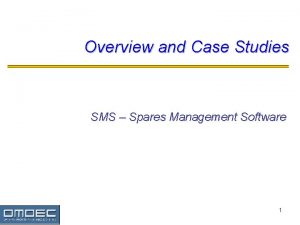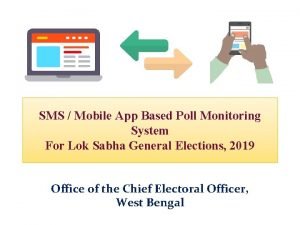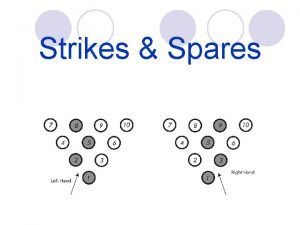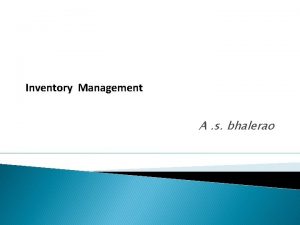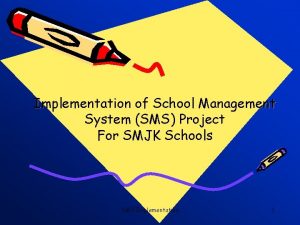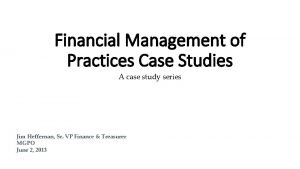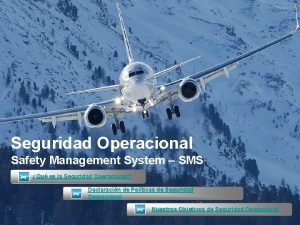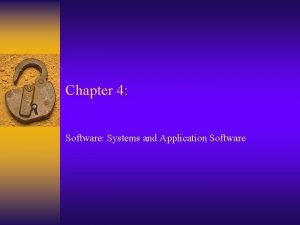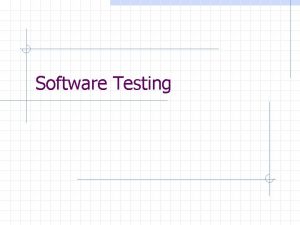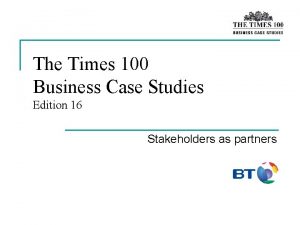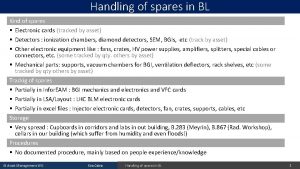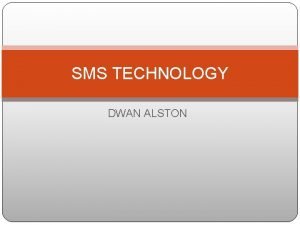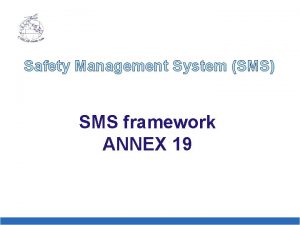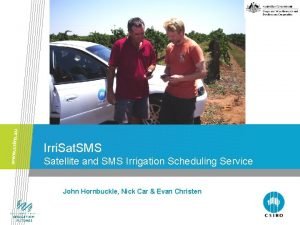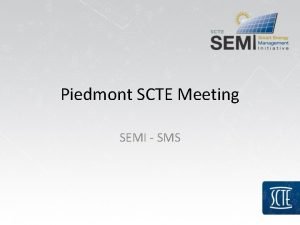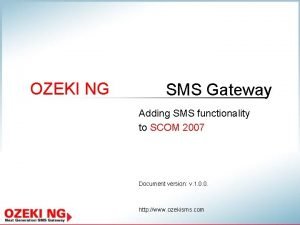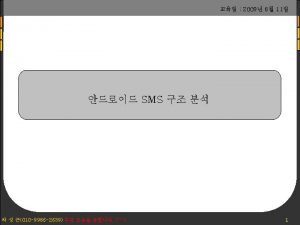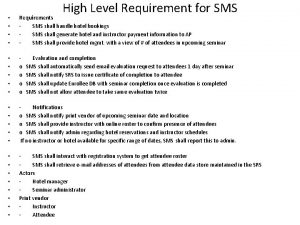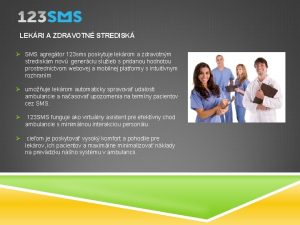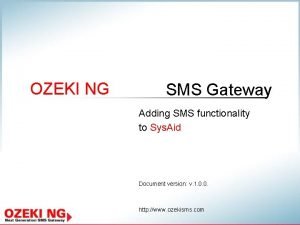Overview and Case Studies SMS Spares Management Software





















- Slides: 21

Overview and Case Studies SMS – Spares Management Software 1

Spares Management Software (SMS) Optimization criteria Non-Repairable Spares Interval Stock Reliability Instant. Stock Reliability Optimal Cost Minimization Requirement Spares Availability Stock Supportability Remaining Life 2

# items in service Repairable Spares Failures time stock failed units repaired units Repair shop 3

Criteria for Decision Making 1. Instant reliability 2. Interval reliability 3. Cost minimization 4. (Process) Availability 4

Scenario • Plant has 62 electric motors on their conveyor systems (Mining company) • MTBReplacements of motors is 3000 days (8 years) • Planning horizon is 1825 days (5 years) • Cost of spare motor is 15, 000 $ • Value of unused spare is 10, 000 $ • Cost of emergency spare is 75, 000 $ • MTTRepair a motor is 80 days • Cost of plant downtime for a single motor is 1000 $ per day • Holding cost of a spare is 4. 11 $ per day (10% of value of part/annum) QUESTION: HOW MANY SPARE PARTS TO STOCK? 5

Results: Repairable Parts Electric motors • Interval reliability: 95% reliability requires 7 spares • Instant reliability: 95% reliability requires 4 spares • Cost minimization: requires 6 spares. Associated plant availability is 100. 00% • Availability of 95%: requires 0 spares. Associated electric motor availability is 97. 4% [Note: If availability of 99% was required (rather than the specified 95%) then spares required would be 2] 6

Reference Case Population 100 transformers Failure Rate Repair Time 0. 005 failures/transformer/yr 1 yr Replacement Time 0. 001 yr Interval 1 yr 7

Repairable Instantaneous Reliability Vary Spares 1 0. 99 0. 98 Reliability 0. 97 0. 96 0. 95 0. 94 0. 93 0. 92 0. 91 0. 9 1 2 3 4 5 Spares 8

Additional Cases Case studies: 1. Fume fan shaft, blast furnace in a steel operation: non-repairable part, decision support 2. Power train component, haul trucks: repairable parts, multiple criteria 3. Frigate control system: supportability interval 9

1. Fume fan shaft – steel mill § Spares provisioning optimization project • • • Part: fume fan shaft used in a Blast Furnace Decision: should there be 0 or 1 spares? Complication: • Part has long lifespan (25 -40 years). • Long lead time (22 weeks). • If part fails, results are catastrophic (loss of almost $6 million per week). • Inventories are trying to be minimized. SMS was used to quantify the risk involved in not having a spare Decision support 10

How many spares – Fume fan shaft? 11

2. Repairable components – haul trucks § Open pit mining operation in South America § Haul truck power train component: COMPONENT X 12

Repairable components - Data / 1 General § 6, 600 operating hours per truck per year (average fleet utilization) § Preventive replacement policy at 9, 000 operating hours in place Time to replacement § Two parameter Weibull distribution, fitted using Weibull++ • 171 events: 86 failures, 85 suspensions (preventive replacements) • Beta = 0. 8565 • Eta = 14, 650 operating hours • Mean time to replacement = 6, 420. 3 operating hours 13

Repairable components - Data / 2 Time to repair § Based on estimations provided by maintenance personnel § Estimated at MTTR = 452 operating hours Cost of downtime and holding costs § Downtime: estimated using operational indicators (value of lost production, $2, 173. 3 / op. hour) § Holding: 25% of the value of the part per annum ($1. 51/ op. hour) 14

Repairable components - Data Summary Parameter Value Number of components in operation 78 MTBReplacements (μ) 6420. 3 (op. hours) Planning horizon (T) 6600 (op. hours) MTTRepair (μR) 452 (op. hours) Holding cost for one spare $1. 51 per op. hour (25% of value of part/annum) Cost of plant downtime for a single component $2173. 3 per op. hour SMS can perform the optimization based on four criteria 15

Repairable components - Results Case & Optimization criteria Optimal Stock level Associated Values Interval Reliability (goal = 95%) 15 Reliability = 98. 05% (for stock=14, Rel. =94. 99%) Instantaneous Reliability (goal = 95%) 10 Reliability = 97. 53% (for stock=9, Rel. =94. 75%) Availability (goal = 99%) 6 Availability = 99. 14 % Cost minimization 14 Total cost per unit time = $23 Inst. Reliability = 99. 94% 16

4. Frigate control system – supportability intervals (S. I. ) § Determination of supportability intervals • • • Several electronic components – control system Parts no longer available - discontinued Decision: how long can we support the operation of the system using only the current stock? (achieving the desired reliability of the stock) 17

Case Study – Supportability Interval (S. I. ) § Summary of Data Supportability interval (RUL of current stock) can be rapidly calculated using SMS – NEWLY ADDED FEATURE 18

Case Study (S. I. ) / 2 § Results Supportability for the system is influenced by the (shortest) supportability for any of its critical parts 19

Case Study (S. I. ) / 3 § Informed decisions for: • • • Adequate timing for replacement of current system Placement of final orders for discontinued parts Maximum supportability interval for current stock – procurement planning 20

Thank you 21
 Spares management software
Spares management software Poll monitoring system app
Poll monitoring system app Php bramka sms
Php bramka sms Strikes and spares
Strikes and spares Spares inventory
Spares inventory Sms school management system
Sms school management system Best case worst case average case
Best case worst case average case Financial management case studies
Financial management case studies Paradigm shift from women studies to gender studies
Paradigm shift from women studies to gender studies Advantages and disadvantages of case control studies
Advantages and disadvantages of case control studies Case series
Case series Student life sms
Student life sms Sms safety management system
Sms safety management system Motivational overview of logic based testing
Motivational overview of logic based testing Software summary
Software summary Collection of programs written to service other programs.
Collection of programs written to service other programs. Overview of multimedia software tools
Overview of multimedia software tools Software testing overview
Software testing overview Algori
Algori Ppm implementation costs
Ppm implementation costs Advantages of case studies in psychology
Advantages of case studies in psychology Times 100 case studies
Times 100 case studies
